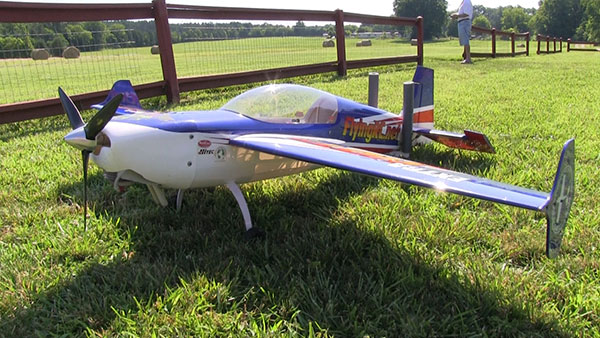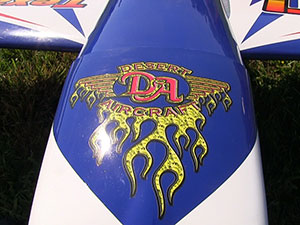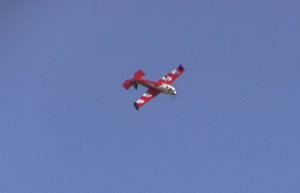



Not many airframes continue to challenge the pilots capabilities by having
so many itself. I have yet to max out this plane.
Text and photos by Tom Hintz
Flight video by Clark Ponthier
Posted – 6-12-2017
With several months of flying under my belt is has become clear that the Extreme Flight 78" Extra 300 has a level of capabilities that my piloting skill set is not likely to fully match. I think this is reality for all the RC pilots that are honest with themselves. The Extreme Flight 78" Extra 300 is just the latest airframe to highlight this disparity in talent.
One thing that really stunned me when I returned to RC flying is the ARF (almost ready to fly) airframes available to us. Having so much of the construction done for us is great considering the hurried lives we lead today. Behind the pre-applied covering (done way better than I ever could) lies an airframe that is very well designed with ultra-precise, laser-cut parts assembled on super-accurate factory jigs. The Extreme Flight 78" Extra 300 is a product of that style of manufacturing that shows how exceptionally light, straight and durable airframes enhance their performance in the air.
I doubt the relatively new 3D segment of the RC world would be as prevalent as it is without these modern airframes. I am amazed at the loads such light airframes can withstand without blowing up in the sky. There will always be s smattering of in-flight failures but nearly all of them can be traced back to something the pilot/builder did rather than a deficiency in the airframe.
The Extreme Flight 78" Extra 300 takes advantage of the power and reliability of today’s gasoline-fueled engines by dramatically increasing the power to weight ratio that greatly expands its flight envelope. Just as important is that the designers and engineers at Extreme Flight understand how to make use of the power to produce such an aerobatic aircraft that is so easy to fly.

Choosing DA power for this plane was
the right thing to do. This airframe can
make use of all that power.
Though designed for 35cc engines the Extreme Flight 78" Extra 300 handles my DA50R very well. Low-speed flight remains surprisingly steady yet it runs straight and true at wide-open-throttle. Since its first flight the Extreme Flight 78" Extra 300 has sported a Mejzlik, 3-blade 20 by 12 carbon fiber prop that seems perfect for the job. Vertical performance is virtually unlimited yet there is enough load to keep the DA50R in a comfortable RPM range no matter which way the nose is aimed.
Of course, the DA50R runs as I would expect from a Desert Aircraft engine. It starts easily, runs smoothly and has the power to pull the Extreme Flight 78" Extra 300 with authority in any direction I point it. So far, the DA50R has not been responsible for a single dead stick landing.
There are precious-few airframes that combine the “walking-speed” landings with such an extensive aerobatic capability. Knife-edge spins are a no-no for not-so-tough airframes but the Extreme Flight 78" Extra 300 cranks them out easily and comes back to Earth with all the parts it went up with. Now, hundreds of such spins later I am confident in the Extreme Flight 78" Extra 300 ability to do these things but truth-be-told, I am always watching for things to fall off. To date, nothing has been ejected or gives the impression it might depart because of these maneuvers.
The latest move I have been learning is the “crankshaft”. I have seen many videos of well-known 3D pilots doing crankshafts and making them look effortless. Over the last weekend I began learning to do the crankshaft maneuver. While the crankshaft itself is reputed to be very tough on airframes I suspect some of the attitudes I sent the Extreme Flight 78" Extra 300 into trying to figure out the crankshaft may have been even more aerodynamically stressful but it survived everything I threw at it.
Because the Extreme Flight 78" Extra 300 needs such low airspeeds to respond to control inputs I could save it when it fell out of failed crankshafts nose down. Let it fall a bit while adding a squirt of power and it responds crisply to the elevator and flies away. Over the last few months I have learned to depend on the near-instant recovery characteristics of the Extreme Flight 78" Extra 300.

Throwing this plane around in the sky
is easy as is recovery. Great design.
The folks that know me best know that I am a fanatical rudder user. The rudder on the Extreme Flight 78" Extra 300 is huge and can respond on that level at nearly any speed. Add some expo and the rudder remains effective but softer around center stick where we want that kind of fine control.
When we have southerly winds at our field I like to do a 45-degree approach to the runway, aiming roughly at the center of the 500-foot-length. As the Extreme Flight 78" Extra 300 gets to the edge of the runway a little right rudder countered by a touch of left aileron keeps the wing level as it turns and lands comfortably down the remaining runway. The Extreme Flight 78" Extra 300 handles so well at lower speeds that this kind of landing approach is surprisingly easy.
I originally equipped the Extreme Flight 78" Extra 300 with a 3 axis “stabilizer” (gyro) but I leave it turned off except on landing in turbulent winds. I felt like it was trying to correct things I wanted the plane to do even though I had the gain settings very low. The Extreme Flight 78" Extra 300 just flies better with huge control surface throws and a moderate amount of expo, around 40%.
When I was trying to learn the “crankshaft” maneuver (practice of this maneuver is in the video below) I felt like the gyro was working against me. When I turned the gyro off the Extreme Flight 78" Extra 300 entered the maneuver more easily and seemed to use its energy more effectively. Other moves such as the knife edge spin were easier to get into and tighter overall with the gyro turned off.
When I got the Extreme Flight 78" Extra 300 my intention was to build a 3D-capable hot rod and that is what I ended up with. The Extreme Flight 78" Extra 300 is very “active” when tossed around in the sky and is far more capable than I am. I like that the Extreme Flight 78" Extra 300 is predictable and consistent, traits that make learning new maneuvers less of a chore. My recent exploration of the Extreme Flight 78" Extra 300 flight envelope also proves that the airframe is very strong and capable of surviving my occasional high-speed dumb-thumbs mistakes that stress the structure more than normal.
With its extensive aerobatic capabilities, the Extreme Flight 78" Extra 300 is a puppy to land. It slows to a walk and floats with the best of them. I have found myself having to add a few clicks of down elevator to help get the Extreme Flight 78" Extra 300 to the ground when landing into winds of 10 mph or more. It just wants to fly when there is a bit of air flowing over the wings.